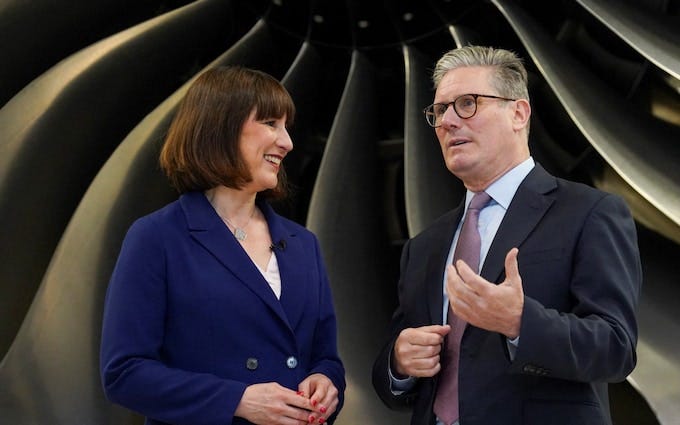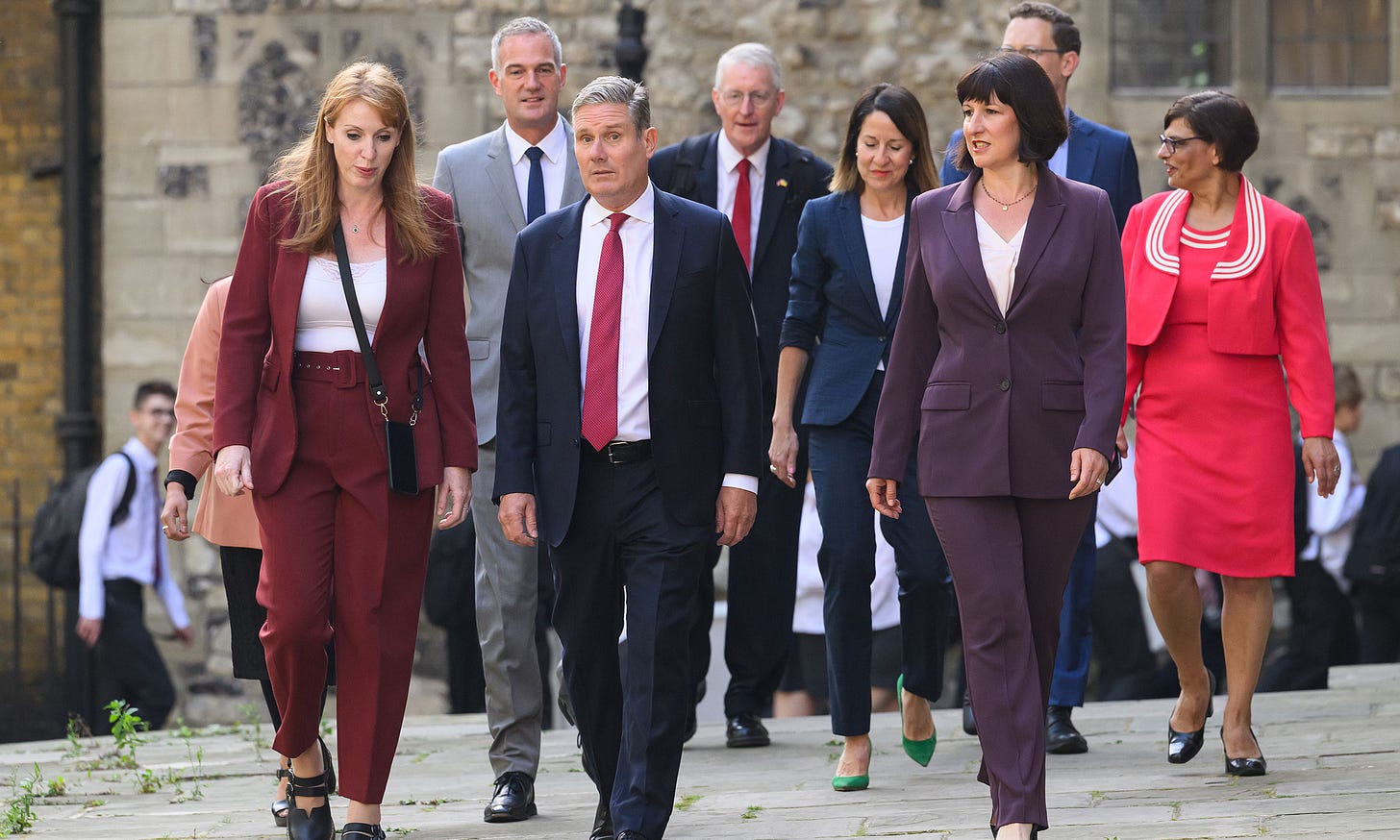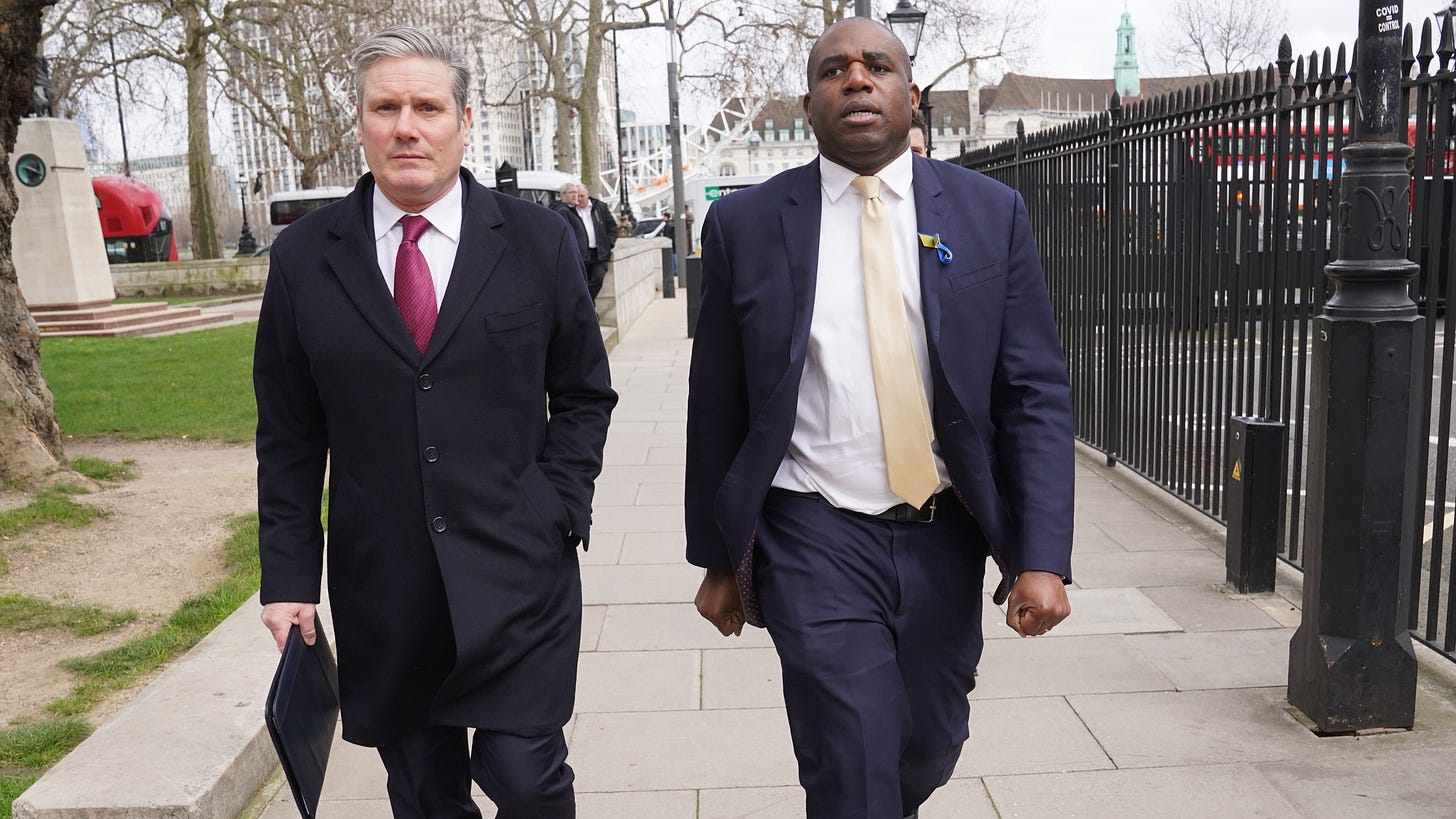How Labour might fit into government
If Sir Keir Starmer does form the next government, how will his opposition team make the transition, who might be left standing when the music stops, and why?
I’ve written a few times about what a Labour government might look like in terms of structure and personnel, as opposed to policy, and here are the relevant essays:
Starmer makes changes for the big push (shadow cabinet reshuffle of September 2023)
First guesses of Starmer’s Whitehall
Labour’s possible civil service picks
The class of 2024: Labour’s new (and old) blood part 1 (expected new MPs)
The class of 2024: Labour’s new (and old) blood part 2
I wanted to come back to this because this week Politico published an article by Dan Bloom entitled “UK election: The great battle for Labour Party jobs”, which touched on many of these subjects. The following day, an item appeared in The Times reporting a rumour that Douglas Alexander, a cabinet minister under Gordon Brown who lost his seat in 2015 but is hoping to return for a different constituency at the forthcoming election, was being considered for a senior position in government if Labour won. It has been suggested that Alexander might even become foreign secretary, supplanting David Lammy who currently shadows the job.
Bloom’s article raised several other issues, some of which I will pull out because I want to expand on them a little. These include:
Too many ministers: there are 131 shadow ministers and whips but a statutory limit of 109 salaried government positions, of which only 95 can be in the House of Commons;
Having criticised the government for its high turn-over of ministers, Sir Keir Starmer will be reluctant to move shadow ministers to different policy areas in any transition into government;
There is an unusually large group of new or returning MPs who might be regarded as strong candidates for ministerial office, and Starmer has proved to be willing to promote new people very quickly: recent by-election winners Simon Lightwood (2022), Ashley Dalton (2023) and Michael Shanks (2023) are already shadow ministers, while their fellow newcomers Andrew Western (2022) and Keir Mather (2023) are whips;
The current government has partially circumvented limits of numbers of ministers by appointing a relatively large cohort of unpaid ministers, which stood at 17 in March;
The cabinet secretary, Simon Case, is thought likely to be eased out by a new Labour government, and Sir Olly Robbins remains a much-mentioned candidate to replace him;
Starmer is thought to be keen to find a role for crossbench peer Baroness Casey of Blackstock;
There may be some reward for Starmer’s campaign director and former chief of staff Morgan McSweeney.
Let us look at the numbers issue first: how does Starmer fit a quart into a pint pot? Bloom acknowledges that the situation will be partially alleviated by some shadow ministers standing down and therefore not requiring a ministerial job. He mentions seven: Holly Lynch, Alex Cunningham, Dr Alan Whitehead, Wayne David, Colleen Fletcher, Kevin Brennan and Barbara Keeley, but since he wrote the article Lyn Brown and Steve McCabe have also announced their departures. That narrows but does not wholly close the gap.
The idea of relying, as the Conservatives have, on a number of unpaid ministers was talked down. One frontbencher told Bloom “our people don’t have the kind of wealth that means they can work for free”, making the contrast with some wealthy Conservative ministers like Lord Benyon and Andrew Griffith for whom a salary, or the lack of one, is not a pressing concern. It is quite fair to dislike the idea of some ministers not being paid, especially if the choice of which ministers appears arbitrary, but it is not accurate to say that unpaid Labour ministers would be “working for free”: MPs receive a basic salary of £91,346 while peers can claim £361 a day tax-free as attendance allowance. Ministerial duties would impose more responsibilities, it is true, but it is more representative to say that they would not be receiving an additional salary to recognise their work rather than that they would be working “for free”. Nevertheless, Starmer may have to decide whether there is a principle at stake.
There will, inevitably, have to be some adjustments, because Starmer has not simply mirrored government posts on a one-for-one basis in shaping his shadow team (nor is he in any way required to). For example, Anneliese Dodds has been “shadow secretary of state for women and equalities”, but the government role which that reflects, minister for women and equalities, is currently an additional role held by the business and trade secretary, Kemi Badenoch. Equally, the Foreign, Commonwealth and Development Office currently has seven ministers, while the opposition team numbers eight (seven MPs and one peer).
One factor influencing Starmer’s decision-making will be that his last shadow cabinet reshuffle, in September 2023, was billed as creating a team which was ready for government. He aligned policy responsibilities with Rishi Sunak’s machinery of government changes made a few months before and was quoted as saying he was putting “strongest possible players on the pitch”, while The Guardian described the Labour leader “seeking to get his favoured team in place before the election”. In any event, Starmer has now been party leader for more than four years, longer than Tony Blair or Harold Wilson had in the top job before becoming prime minister, and has had ample time to choose his best players. At the top level, therefore, there is likely to be a high degree of straightforward transition from shadow to substantive portfolio.
(Starmer has more freedom than some of his predecessors: Labour Party rules used to require a leader coming into government to include all shadow cabinet members in a new cabinet, and that was when the shadow cabinet was elected by the Parliamentary Labour Party, a procedure scrapped in 2011.)
That does, however, assume that Starmer himself will not make any major changes to the structure of Whitehall or divisions of responsibility within government. He had initially promised to undo the 2020 merger of the Foreign and Commonwealth Office and the Department for International Development, restoring overseas aid to an autonomous cabinet role, but began to back away from that commitment last summer. David Lammy’s recent speech on Labour’s foreign policy was conspicuously silent on the idea and it seems likely that the merger will not be undone.
When I considered potential departmental changes in April, no major reforms struck me as especially likely, although the Department for Levelling Up, Housing and Communities, expected to be placed in Angela Rayner’s hands as deputy prime minister, could be rebranded and/or given more powers and responsibilities. Although The Times reported in August last year that Sue Gray, Starmer’s chief of staff and a former permanent secretary, was planning an “overhaul of Whitehall”, this seems to be more about how ministers and departments interact and ensure effective policy delivery. A Labour Party insider was quoted as saying:
Some of that will be about traditional machinery of government changes—are the departments we will inherit the right ones—but also things like, can you do more with cabinet committees, or have cross-government teams with a specific focus?
The potential disruption to this smooth transition comes if Starmer is either dissatisfied with any of his shadow cabinet team, or if he wants to include new people at the highest level of government. I mentioned above rumours that Douglas Alexander, if he is elected MP for East Lothian, has been named as a potential alternative foreign secretary: unlike Lammy, who was a junior minister from 2002 to 2010 but never rose higher than minister of state, Alexander was transport secretary and Scotland secretary (2006-07) then international development secretary (2007-10). A Labour source told The Times:
There is an expectation that he will and should be part of the top team. He brings experience, he brings intellect and is a good voice in the media.
That said, denying Lammy would be a big decision. He has been shadowing foreign affairs for two and a half years and has recently been very active in building contacts in the United States, especially with senior Republicans in case Donald Trump wins November’s presidential election. It is also impossible to deny that some would see a racial element in any diminution of Lammy’s status. It is hard to see what he might be offered as compensation: the other great offices of state, the Treasury and the Home Office, are locked down for their shadows, though it is not inconceivable he could be offered the post of justice secretary and lord chancellor, which he shadowed in 2020-21.
It is hard to argue that any of the shadow cabinet has seriously underperformed. Liz Kendall, appointed shadow work and pensions secretary last September, was forced to take several weeks off earlier this year for a hip replacement operation, which has blunted her profile somewhat (one of her junior spokesmen, Alison McGovern, stood in for her). Nick Thomas-Symonds, shadow minister without portfolio, might have to accept a job outside cabinet, as his opposite number, Richard Holden, holds the post primarily because he is chairman of the Conservative Party; moreover, Thomas-Symonds was not a striking success as shadow home secretary in 2020-21 or shadow international trade secretary in 2021-23. Ellie Reeves (sister of the shadow chancellor Rachel Reeves) sits in the shadow cabinet as the Labour Party’s deputy national campaign co-ordinator, so has no equivalent role to inherit and may therefore have to accept a senior non-cabinet ministerial post. She was previously shadow solicitor general and then shadow justice minister so may find herself at the Ministry of Justice.
It will be interesting to see where Baroness Casey finds herself. She is an interesting and slightly unusual figure: starting as a civil servant and then inhabiting the NGO and charity world for some years, she was brought into the centre of government under Tony Blair in 1997 to head the Social Exclusion Unit, then in 1999 became director of the Rough Sleepers’ Unit (and was dubbed the government’s “homelessness czar”). In 2003, she moved to the Home Office to run the Anti-Social Behaviour Unit, then from 2005 to 2007 she headed the Respect Task Force. She has remained a favourite choice to head inquiries and reviews, most recently into misconduct in the Metropolitan Police, and was awarded a life peerage in 2020.
Her reputation for effectiveness and efficiency is formidable and prized in Whitehall, and she has developed expertise in some of the knottiest and most intertwined issues of social and economic deprivation. Last summer, she told the BBC that she would accept a role in a future Labour government if it were one which meant she “could get something done”, though she downplayed the idea of a ministerial role.
Whether you employ people like me to be a sort of tsar figure or whether you get a minister to do the job they’re doing, what we need is high quality people. And, you know, there are plenty of people younger than me that could do it as well.
However, she admitted she would “love to” chair some kind of large-scale review of welfare, a modern equivalent of the Beveridge Report of 1942. It is not clear what Starmer might have in mind. A recent story in The Times led with the possibility of a “ministerial role” but became more guarded and vague, noting that she had also been linked with Labour’s proposed ethics and integrity commission to regulate conduct in Whitehall and with a role as “missions tsar”, “corralling government departments to work together to deliver Labour’s five signature pledges on health, education, crime, net zero and the economy”. Much will hinge on whether Starmer and Casey can agree a significant and productive role, whether ministerial or not, or if the Labour leader simply wants Casey’s name attached to his government to show serious intent in policy delivery.
The underlying theme here is that any transition from opposition to government entails compromises, changes and disappointments. The question for Sir Keir Starmer is how much aggravation he feels he can or needs to cause in constructing an effective government. Dan Bloom in his Politico article quoted a shadow cabinet minister who urged Starmer to be bold, emphasising how much political capital he would have in the wake of a general election victory. “You’re never more powerful than on day one,” the source concluded. We are perhaps seeing some reflection of that in the series of left-wing figures who have been barred or removed from parliamentary candidacies—Jeremy Corbyn, Lloyd Russell-Moyle, Dr Faiza Shaheen, perhaps Diane Abbott. It may be that Starmer thinks this is a necessary step but inevitably messy and controversial, so best undertaken while he enjoys a strong poll lead.
Creating a coherent picture of Starmer is challenging, as he can be both ruthless and indecisive, brutally sectarian yet vacillatingly willing to compromise. Assembling a government is hard, especially after 14 years in opposition, and it will be interesting to see which way he leans on various issues if the circumstances arise. There are still more than four weeks to scrutinise and dissect for clues.






Let's see if Baroness Casey is brought in early doors to fulfil a 'headline' role as you suggested. Labour are going to need to do something bold alongside all the usual dross of taking over. So far, my read on their pledges is that they're unambitious (because they don't know the scale of what is left behind?) and Casey could certainly lead something enterprising to ensure a positive direction for the general public/press.